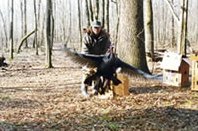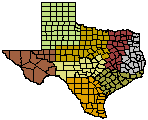- Bobwhite Quail
- Mourning Dove
- Wild Turkey
Post Oak Savannah and
Blackland Prairie Wildlife Management
Wild Turkey

There are two sub-species of wild turkey that occur in the Post Oak Savannah and Blackland Prairie regions:
1. Eastern Wild Turkey (Meliagris gallopavo sylvestris), and
2. Rio Grande Wild Turkey (Meleagris gallopavo intermedia).
Beginning in 1987, Eastern wild turkeys were re-stocked into most counties of the Post Oak Savannah where enough suitable habitats were present. Rio Grande wild turkey have been re-stocked throughout Texas where average annual precipitation is less that 35 inches. Re-stocking efforts have since concluded and populations of Eastern and Rio Grande wild turkeys have been re-established in several counties in the Post Oak Savannah and Blackland Prairie regions. Eastern wild turkeys are currently present in the northern and eastern counties of the Post Oak Savannah. Rio Grande wild turkeys are present in counties along the western edge of the Blackland Prairie region and southern counties of the Post Oak Savannah region.
As with all wildlife, habitat is the single most important factor in maintaining healthy and viable populations of wild turkey in the Post Oak Savannah and Blackland Prairie regions. The wild turkeys are members of the same family as the bobwhite quail (Family Galliformes), therefore, many of the same habitat factors that limit bobwhite populations also limit wild turkey populations, especially those concerning nesting and brood rearing habitat.
Wild turkeys are a resident non-migratory species, with a home range that averages about 2,000 to 5,000 acres and changes seasonally. During spring and summer, which is the nesting and brood rearing period, turkeys tend to be widely dispersed in habitats that contain scattered thickets of low growing brush, patches of residual herbaceous vegetation and a diverse grass/forb plant community that produces abundant seed and insects. During fall and winter, turkeys tend to congregate into large flocks that have ranges centered around riparian areas (flood plains of major creeks and rivers) containing large stands of mature hardwood trees.
Habitat management for wild turkeys should be concerned with the availability and distribution of food, cover, and water. The following sections will outline the basic habitat components for wild turkeys and the management practices used to establish or maintain them.
Food
Wild turkeys are opportunistic feeders, meaning they will generally eat what is available as they encounter it. The diet of the wild turkey is also omnivorous, meaning that it consist of a wide variety of plant and animal matter. However, the principal food items of the wild turkeys include mast (acorns and nuts), fruits, seeds, green plant matter, agricultural crops and animal matter (insects). Some important plants for wild turkeys include:
1. Oaks (acorns),
2. Hickories and pecan (nuts),
3. Partridge pea (seed),
4. Croton (seed),
5. Mesquite (seed),
6. Dogwood (fruit),
7. Sumac (fruit),
8. American beauty-berry (fruit),
9. Grape (fruit),
10. Blackberry and dewberry (fruit),
11. Hackberry (fruit),
12. Cedar elm (fruit),
13. Paspalum grasses (seed), and
14. Panicum grasses (seed).
Production of important seed and mast producing plants can be encouraged by implementing practices such as prescribed burning, fallow disking, rotational grazing, food plots, and timber management.
Cover
Cover requirements for wild turkey can be broken down into three distinct categories:
1. Nesting Cover
2. Brood rearing cover, and
3. Roosting Cover
Nesting cover for wild turkey typically contain a dense herbaceous layer and some shrubs, or brush, cover near ground level. Turkey nests are generally located close to openings near some type of structure. Nesting cover for turkeys can be promoted by excluding areas along woodland edges from mowing or grazing and protecting areas with existing brush or dense herbaceous vegetation from disturbance.
Brood rearing cover, commonly referred to as bugging areas, is the most important component of the wild turkey's habitat and is typified by areas having a diverse mixture of grasses and forbs that produce abundant insects. As with quail chicks, turkey poults require a high protein diet of insects and spiders during the early stages of growth. Additionally, good brood rearing habitat needs to be tall enough to conceal the poults from predators, yet short enough for the hen to see over (about 3 feet tall). Brood rearing habitat can be maintained by rotating livestock on native pastures, prescribed burning (3-year rotation), and fallow disking.
Wild turkeys prefer to roost in large, mature hardwood or coniferous trees with large horizontal limbs. Therefore, care should be taken to protect these trees from land clearing operations, especially along creeks, drainage areas, and wetlands.
Water
Turkeys, like all other terrestrial animals, require water for survival. Wild turkeys are able to get water from green plant material, fruits, insects, dew and free water from puddles, ponds, creeks and rivers. In the Post Oak Savannah and Blackland Prairie, water is generally not considered a limiting factor in habitat, except during extreme periods of drought.
Summary
For the most part, wild turkey restoration efforts in certain portions of
the Post Oak Savannah and Blackland Prairies regions have been a success.
However, with the imminent threat of land fragmentation, the future of wild
turkeys in these regions is not certain. To perpetuate the wild turkey in
these regions, land managers must be able to recognize the habitat components
essential to these birds, and implement the land management practices necessary
in maintaining a healthy habitat. Also, in dealing with the issues of land
fragmentation, landowners will need to work together more than ever. Therefore,
landowner wildlife management associations (co-op's) will be an important
part of wildlife habitat management as we progress through the 21st century.
For assistance in developing a habitat management plan for your property, please contact your local Texas Parks and Wildlife Biologist.
To locate the wildlife biologist in your area CLICK HERE.
 Texas Parks and Wildlife Department
Texas Parks and Wildlife Department